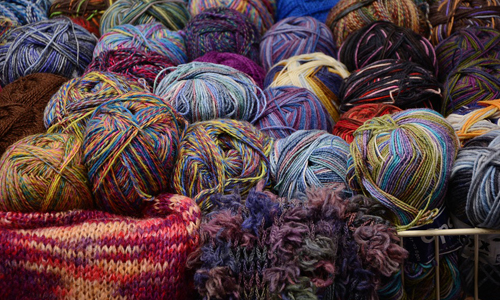A Thorough Guide to Help you Understand Natural and Synthetic Fabrics
Author

Apart from her desk job, Diana is a health and fitness blogger and is working with the leading fitness clothing brand LIVE! Clothing UK. She is very keen on building a better physique, and so she always finds time for her daily workout. Her motto is “Be better than you were yesterday and everything will be better tomorrow.”
While it is rather easy to decide on prints, cuts and styles, the quality of fabric remains a prior concern while investing in winter clothes. After all, you practically live in those and checking for comfort and softness is natural.
Winter has come and if you’re on the hunt for clothes that feel as brilliant and plush as they look, it is vital to understand the different fabrics they are made of. While the cosiest sweater that you most readily wear every third day could be the natural wool or cashmere, the other one that you have known to be water-resistant and quick-drying- your go-to pick when its foggy, could be the synthetic acrylic.
Which Fabric is Warmer - Natural or Synthetic?
Contrary to the popular belief that all natural fabrics are warmer than synthetic fabrics, only those natural fabrics that are obtained from animals can be regarded. For example, polyester, which is a synthetic fabric can be warmer than the cotton which is plant-obtained.
On the other hand, the soft, strong and durable wool, obtained from the hair of a camelid, is always warmer than any synthetic fabric. It not only provides warmth, but also has an attractive appearance along with moisture wicking properties. The breathable wool is resistant to wrinkles, dirt and daily wear and tear. It is found in almost any basic winter wardrobe.
It not only provides warmth, but also has an attractive appearance along with moisture wicking properties. The breathable wool is resistant to wrinkles, dirt and daily wear and tear. It is found in almost any basic winter wardrobe.
The Lightweight and Delicate Natural Fabrics
Natural fabrics, such as the plush merino wool, cotton, silk and cashmere are produced by plants, animals, and geological processes. These fabrics are recognised for their lustre, beauty and luxurious look. Silk, for instance, drapes well and is often commended as the queen of all fabrics. Cotton, on the other hand, gives the most soothing and comfortable feel against the skin and is versatile as it can keep you both warm and cool.
The Low-Maintenance Synthetic Fabrics
The man-made, or synthetic fabrics are produced in laboratories with all qualities including the length, fineness, strength and elasticity being fully controlled. Consequently, the strength of these fabrics are greater than that of natural fabrics.
What Makes Wool Warmer Than Synthetic?
The wool fabric has a natural loft that traps heat to provide humans guard against the cold inclement weather, just as they protect their animal counterparts. It has inbuilt insulating and moisture-wicking properties to help both, the camelids and humans survive in varying weather conditions.
Understanding the Acrylic Fabric
The acrylic yarn might not have the warmth of alpaca or sheep wool, but it will efficiently keep you cosy on a cold winter day. It is a versatile synthetic fabric which is soft against the skin and provides lightweight comfort. However, it is still plastic and therefore, not as breathable as wool or cashmere!
Benefits of Blending Acrylic with Wool
If the tag on your favourite sweater does not say 100% wool, chances are it is fashioned with a blend of wool and a synthetic fibre - say acrylic or nylon. This unique combination results in a stylish and warm sweater which is more affordable, durable and versatile than pure wool or cashmere sweaters.
This unique combination results in a stylish and warm sweater which is more affordable, durable and versatile than pure wool or cashmere sweaters.
Summary
The growing popularity of synthetic fabrics can be associated with their better durability and cheaper manufacturing. However, the blend of synthetic and natural fabrics help you get the best of both worlds, making them an ideal choice.
Author

Apart from her desk job, Diana is a health and fitness blogger and is working with the leading fitness clothing brand LIVE! Clothing UK. She is very keen on building a better physique, and so she always finds time for her daily workout. Her motto is “Be better than you were yesterday and everything will be better tomorrow.”
- 5 Essential Tips for Improving Your Running Form and Performance
- 5 Walking Challenges for Hiking Lovers
- Devon's Finest Camping Gems: Coastal Havens to Countryside Escapes
- Empowering Women Backpackers: Essential Tips for Unforgettable Adventures
- Time-Saving Tips for Busy Cyclists: Maximising Riding Opportunities
Categories
- Sport (28)
- Product Reviews (3)
- Team Outdoor Look (7)
- Mike Wild (2)
- Mike Payton (2)
- Suse Hammond-Pears (3)
- Snowboarding (12)
- Latest Offers (105)
- Shop Talk (1)
- Competitions (7)
- Walking (413)
- Lifestyle Fashion (8)
- Travel (86)
- Kit Guides (176)
- Workwear Clothing (6)
- Safety Workwear (4)
- Health/Fitness (289)
- Skiing (91)
- Great Outdoors (1316)
- Cycling (92)
- January 2025
- December 2024
- November 2024
- October 2024
- September 2024
- August 2024
- July 2024
- June 2024
- May 2024
- April 2024
- March 2024
- February 2024
- January 2024
- December 2023
- November 2023
- October 2023
- September 2023
- August 2023
- July 2023
- June 2023
- May 2023
- April 2023
- March 2023
- February 2023
- January 2023
- December 2022
- November 2022
- October 2022
- September 2022
- August 2022
- July 2022
- June 2022
- May 2022
- April 2022
- March 2022
- February 2022
- January 2022
- December 2021
- November 2021
- October 2021
- September 2021
- August 2021
- July 2021
- June 2021
- May 2021
- April 2021
- March 2021
- February 2021
- January 2021
- December 2020
- November 2020
- October 2020
- September 2020
- August 2020
- July 2020
- June 2020
- May 2020
- April 2020
- March 2020
- February 2020
- January 2020
- December 2019
- November 2019
- October 2019
- September 2019
- August 2019
- July 2019
- June 2019
- May 2019
- April 2019
- March 2019
- February 2019
- January 2019
- December 2018
- November 2018
- October 2018
- September 2018
- August 2018
- July 2018
- June 2018
- May 2018
- April 2018
- March 2018
- February 2018
- January 2018
- December 2017
- November 2017
- October 2017
- September 2017
- August 2017
- July 2017
- June 2017
- May 2017
- April 2017
- March 2017
- February 2017
- January 2017
- December 2016
- November 2016
- October 2016
- September 2016
- August 2016
- July 2016
- June 2016
- May 2016
- April 2016
- March 2016
- February 2016
- January 2016
- December 2015
- November 2015
- October 2015
- September 2015
- August 2015
- July 2015
- June 2015
- May 2015
- April 2015
- March 2015
- February 2015
- January 2015
- December 2014
- November 2014
- October 2014
- September 2014
- August 2014
- July 2014
- June 2014
- May 2014
- April 2014
- March 2014
- February 2014
- January 2014
- December 2013
- November 2013
- October 2013
- September 2013
- August 2013
- July 2013
- June 2013
- May 2013
- April 2013
- March 2013
- February 2013
- January 2013
- December 2012
- November 2012
- October 2012
- September 2012
- August 2012
- July 2012
- June 2012
- May 2012
- April 2012
- March 2012
- February 2012
- January 2012
- December 2011
- November 2011
- October 2011
- September 2011
- August 2011
- May 2010
- April 2010
- March 2010
- February 2010
- January 2010
- November 2009
- October 2009
- September 2009
Submit a Comment